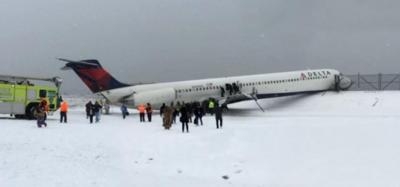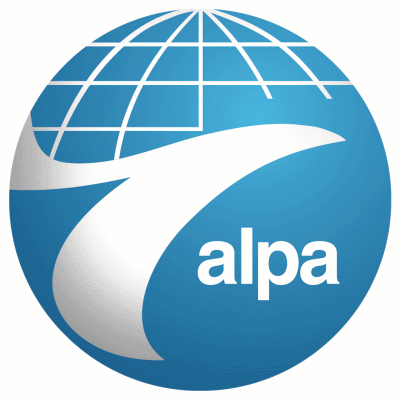Pilot Error Cited In Delta MD-88 Runway Excursion
The application of excessive reverse thrust during a landing at LaGuardia Airport, New York, March, 5, 2015, led to a loss of directional control and the passenger jet’s departure from the snow covered runway, according to findings of the National Transportation Safety Board announced during a public meeting Tuesday.

Delta Airlines flight 1086 landed on LaGuardia Airport’s runway 13, veered to the left and departed the side of the runway, contacted the airport perimeter fence and came to rest with the airplane’s nose on an embankment next to Flushing Bay.
The NTSB investigation found that the probable cause of the accident – in which 29 of 127 passengers suffered minor injuries – was the captain’s inability to maintain directional control of the Boeing MD -88 due to his application of excessive reverse thrust, which degraded the effectiveness of the rudder in controlling the airplane heading. The aircraft was substantially damaged.
“The passengers and crew of Delta flight 1086 were fortunate to have survived this crash with no loss of life or serious injuries,” said NTSB Chairman Christopher Hart. “Proper use, in real time, of precise, accurate, and timely information about the condition of the runway can help make winter operations safer, as well as the study and use of large quantities of data to inform best practices. If today’s recommendations are acted upon, future landings on contaminated runways will be safer because of actions to enable the timely communication and use of information to eliminate potentially life-threatening unknowns.”
The NTSB investigation also revealed that, during the accident sequence, damage to the aircraft resulted in the loss of the interphone and public address system as methods of communication after the accident. As a result, the announcement to evacuate the aircraft was delayed and more than 17 minutes passed before all passengers were off the aircraft.
The NTSB made 10 recommendations to the Federal Aviation Administration, two to Boeing, one to the U.S. operators of MD-80 series airplanes, and one to the Port Authority of New York and New Jersey.
ALPA disagreed with the finding of a single probable cause of the accident.

“The NTSB’s single probable cause failed to fully and directly acknowledge the multiple factors that contributed to the accident. The NTSB’s Performance Study in this investigation concluded that a combination of factors including asymmetric thrust, crosswind, and runway friction caused the aircraft to deviate from the runway heading. As a result of the NTSB’s focus on a single probable cause, the airline industry has missed a valuable opportunity to address the multiple factors involved in the event with the goal of advancing aviation safety,” the union said in a statement released to the media.
“In addition, ALPA points out that the NTSB’s investigation found that the flight crew was well prepared for the approach and that their established landing requirements were consistent with company policies. Additionally, the NTSB found that the flight crew’s decision to continue their approach and landing was ‘not inappropriate.’”
“ALPA is concerned that the NTSB inadequately highlighted the lack of timely and accurate runway condition measuring and reporting information available to the pilots. ALPA welcomes the new voluntary Federal Aviation Administration standards and best practices for determining and reporting runway condition information, which will go into effect on October 1. The new standards mark key progress in runway condition data gathering and information sharing that ALPA has sought for decades. The new guidance will provide pilots with improved data regarding runway conditions before they are able to see the runway, enhancing the safety of air transportation for all who depend on it.”
(Source: NTSB news release, ALPA statement. NTSB image)
 ANN's Daily Aero-Linx (08.27.25)
ANN's Daily Aero-Linx (08.27.25) ANN's Daily Aero-Term (08.27.25): Class C Service
ANN's Daily Aero-Term (08.27.25): Class C Service ANN FAQ: Submit a News Story!
ANN FAQ: Submit a News Story! Airborne-NextGen 08.26.25: Iran UAV Knockoffs, X-37B Spaceplane, Army Training
Airborne-NextGen 08.26.25: Iran UAV Knockoffs, X-37B Spaceplane, Army Training Classic Klyde Morris (08.25.25)
Classic Klyde Morris (08.25.25)




